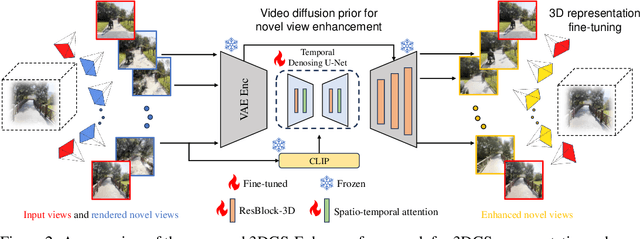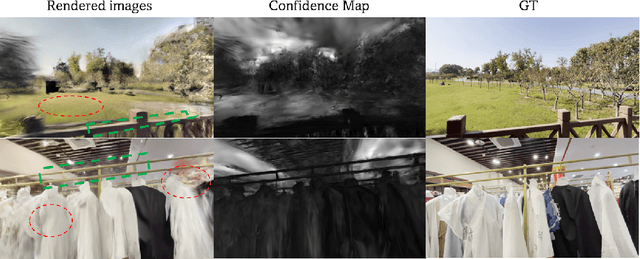Siyu Huang
Bézier Splatting for Fast and Differentiable Vector Graphics
Mar 20, 2025Abstract:Differentiable vector graphics (VGs) are widely used in image vectorization and vector synthesis, while existing representations are costly to optimize and struggle to achieve high-quality rendering results for high-resolution images. This work introduces a new differentiable VG representation, dubbed B\'ezier splatting, that enables fast yet high-fidelity VG rasterization. B\'ezier splatting samples 2D Gaussians along B\'ezier curves, which naturally provide positional gradients at object boundaries. Thanks to the efficient splatting-based differentiable rasterizer, B\'ezier splatting achieves over 20x and 150x faster per forward and backward rasterization step for open curves compared to DiffVG. Additionally, we introduce an adaptive pruning and densification strategy that dynamically adjusts the spatial distribution of curves to escape local minima, further improving VG quality. Experimental results show that B\'ezier splatting significantly outperforms existing methods with better visual fidelity and 10x faster optimization speed.
Latent Radiance Fields with 3D-aware 2D Representations
Feb 13, 2025Abstract:Latent 3D reconstruction has shown great promise in empowering 3D semantic understanding and 3D generation by distilling 2D features into the 3D space. However, existing approaches struggle with the domain gap between 2D feature space and 3D representations, resulting in degraded rendering performance. To address this challenge, we propose a novel framework that integrates 3D awareness into the 2D latent space. The framework consists of three stages: (1) a correspondence-aware autoencoding method that enhances the 3D consistency of 2D latent representations, (2) a latent radiance field (LRF) that lifts these 3D-aware 2D representations into 3D space, and (3) a VAE-Radiance Field (VAE-RF) alignment strategy that improves image decoding from the rendered 2D representations. Extensive experiments demonstrate that our method outperforms the state-of-the-art latent 3D reconstruction approaches in terms of synthesis performance and cross-dataset generalizability across diverse indoor and outdoor scenes. To our knowledge, this is the first work showing the radiance field representations constructed from 2D latent representations can yield photorealistic 3D reconstruction performance.
3DGS-Enhancer: Enhancing Unbounded 3D Gaussian Splatting with View-consistent 2D Diffusion Priors
Oct 21, 2024



Abstract:Novel-view synthesis aims to generate novel views of a scene from multiple input images or videos, and recent advancements like 3D Gaussian splatting (3DGS) have achieved notable success in producing photorealistic renderings with efficient pipelines. However, generating high-quality novel views under challenging settings, such as sparse input views, remains difficult due to insufficient information in under-sampled areas, often resulting in noticeable artifacts. This paper presents 3DGS-Enhancer, a novel pipeline for enhancing the representation quality of 3DGS representations. We leverage 2D video diffusion priors to address the challenging 3D view consistency problem, reformulating it as achieving temporal consistency within a video generation process. 3DGS-Enhancer restores view-consistent latent features of rendered novel views and integrates them with the input views through a spatial-temporal decoder. The enhanced views are then used to fine-tune the initial 3DGS model, significantly improving its rendering performance. Extensive experiments on large-scale datasets of unbounded scenes demonstrate that 3DGS-Enhancer yields superior reconstruction performance and high-fidelity rendering results compared to state-of-the-art methods. The project webpage is https://xiliu8006.github.io/3DGS-Enhancer-project .
Fundus to Fluorescein Angiography Video Generation as a Retinal Generative Foundation Model
Oct 17, 2024Abstract:Fundus fluorescein angiography (FFA) is crucial for diagnosing and monitoring retinal vascular issues but is limited by its invasive nature and restricted accessibility compared to color fundus (CF) imaging. Existing methods that convert CF images to FFA are confined to static image generation, missing the dynamic lesional changes. We introduce Fundus2Video, an autoregressive generative adversarial network (GAN) model that generates dynamic FFA videos from single CF images. Fundus2Video excels in video generation, achieving an FVD of 1497.12 and a PSNR of 11.77. Clinical experts have validated the fidelity of the generated videos. Additionally, the model's generator demonstrates remarkable downstream transferability across ten external public datasets, including blood vessel segmentation, retinal disease diagnosis, systemic disease prediction, and multimodal retrieval, showcasing impressive zero-shot and few-shot capabilities. These findings position Fundus2Video as a powerful, non-invasive alternative to FFA exams and a versatile retinal generative foundation model that captures both static and temporal retinal features, enabling the representation of complex inter-modality relationships.
AutoAL: Automated Active Learning with Differentiable Query Strategy Search
Oct 17, 2024Abstract:As deep learning continues to evolve, the need for data efficiency becomes increasingly important. Considering labeling large datasets is both time-consuming and expensive, active learning (AL) provides a promising solution to this challenge by iteratively selecting the most informative subsets of examples to train deep neural networks, thereby reducing the labeling cost. However, the effectiveness of different AL algorithms can vary significantly across data scenarios, and determining which AL algorithm best fits a given task remains a challenging problem. This work presents the first differentiable AL strategy search method, named AutoAL, which is designed on top of existing AL sampling strategies. AutoAL consists of two neural nets, named SearchNet and FitNet, which are optimized concurrently under a differentiable bi-level optimization framework. For any given task, SearchNet and FitNet are iteratively co-optimized using the labeled data, learning how well a set of candidate AL algorithms perform on that task. With the optimal AL strategies identified, SearchNet selects a small subset from the unlabeled pool for querying their annotations, enabling efficient training of the task model. Experimental results demonstrate that AutoAL consistently achieves superior accuracy compared to all candidate AL algorithms and other selective AL approaches, showcasing its potential for adapting and integrating multiple existing AL methods across diverse tasks and domains. Code will be available at: https://github.com/haizailache999/AutoAL.
Multimodal Generalized Category Discovery
Sep 18, 2024



Abstract:Generalized Category Discovery (GCD) aims to classify inputs into both known and novel categories, a task crucial for open-world scientific discoveries. However, current GCD methods are limited to unimodal data, overlooking the inherently multimodal nature of most real-world data. In this work, we extend GCD to a multimodal setting, where inputs from different modalities provide richer and complementary information. Through theoretical analysis and empirical validation, we identify that the key challenge in multimodal GCD lies in effectively aligning heterogeneous information across modalities. To address this, we propose MM-GCD, a novel framework that aligns both the feature and output spaces of different modalities using contrastive learning and distillation techniques. MM-GCD achieves new state-of-the-art performance on the UPMC-Food101 and N24News datasets, surpassing previous methods by 11.5\% and 4.7\%, respectively.
SoftShadow: Leveraging Penumbra-Aware Soft Masks for Shadow Removal
Sep 11, 2024Abstract:Recent advancements in deep learning have yielded promising results for the image shadow removal task. However, most existing methods rely on binary pre-generated shadow masks. The binary nature of such masks could potentially lead to artifacts near the boundary between shadow and non-shadow areas. In view of this, inspired by the physical model of shadow formation, we introduce novel soft shadow masks specifically designed for shadow removal. To achieve such soft masks, we propose a \textit{SoftShadow} framework by leveraging the prior knowledge of pretrained SAM and integrating physical constraints. Specifically, we jointly tune the SAM and the subsequent shadow removal network using penumbra formation constraint loss and shadow removal loss. This framework enables accurate predictions of penumbra (partially shaded regions) and umbra (fully shaded regions) areas while simultaneously facilitating end-to-end shadow removal. Through extensive experiments on popular datasets, we found that our SoftShadow framework, which generates soft masks, can better restore boundary artifacts, achieve state-of-the-art performance, and demonstrate superior generalizability.
EyeCLIP: A visual-language foundation model for multi-modal ophthalmic image analysis
Sep 10, 2024Abstract:Early detection of eye diseases like glaucoma, macular degeneration, and diabetic retinopathy is crucial for preventing vision loss. While artificial intelligence (AI) foundation models hold significant promise for addressing these challenges, existing ophthalmic foundation models primarily focus on a single modality, whereas diagnosing eye diseases requires multiple modalities. A critical yet often overlooked aspect is harnessing the multi-view information across various modalities for the same patient. Additionally, due to the long-tail nature of ophthalmic diseases, standard fully supervised or unsupervised learning approaches often struggle. Therefore, it is essential to integrate clinical text to capture a broader spectrum of diseases. We propose EyeCLIP, a visual-language foundation model developed using over 2.77 million multi-modal ophthalmology images with partial text data. To fully leverage the large multi-modal unlabeled and labeled data, we introduced a pretraining strategy that combines self-supervised reconstructions, multi-modal image contrastive learning, and image-text contrastive learning to learn a shared representation of multiple modalities. Through evaluation using 14 benchmark datasets, EyeCLIP can be transferred to a wide range of downstream tasks involving ocular and systemic diseases, achieving state-of-the-art performance in disease classification, visual question answering, and cross-modal retrieval. EyeCLIP represents a significant advancement over previous methods, especially showcasing few-shot, even zero-shot capabilities in real-world long-tail scenarios.
Fundus2Video: Cross-Modal Angiography Video Generation from Static Fundus Photography with Clinical Knowledge Guidance
Aug 27, 2024



Abstract:Fundus Fluorescein Angiography (FFA) is a critical tool for assessing retinal vascular dynamics and aiding in the diagnosis of eye diseases. However, its invasive nature and less accessibility compared to Color Fundus (CF) images pose significant challenges. Current CF to FFA translation methods are limited to static generation. In this work, we pioneer dynamic FFA video generation from static CF images. We introduce an autoregressive GAN for smooth, memory-saving frame-by-frame FFA synthesis. To enhance the focus on dynamic lesion changes in FFA regions, we design a knowledge mask based on clinical experience. Leveraging this mask, our approach integrates innovative knowledge mask-guided techniques, including knowledge-boosted attention, knowledge-aware discriminators, and mask-enhanced patchNCE loss, aimed at refining generation in critical areas and addressing the pixel misalignment challenge. Our method achieves the best FVD of 1503.21 and PSNR of 11.81 compared to other common video generation approaches. Human assessment by an ophthalmologist confirms its high generation quality. Notably, our knowledge mask surpasses supervised lesion segmentation masks, offering a promising non-invasive alternative to traditional FFA for research and clinical applications. The code is available at https://github.com/Michi-3000/Fundus2Video.
Single-Image Shadow Removal Using Deep Learning: A Comprehensive Survey
Jul 11, 2024



Abstract:Shadow removal aims at restoring the image content within shadow regions, pursuing a uniform distribution of illumination that is consistent between shadow and non-shadow regions. {Comparing to other image restoration tasks, there are two unique challenges in shadow removal:} 1) The patterns of shadows are arbitrary, varied, and often have highly complex trace structures, making ``trace-less'' image recovery difficult. 2) The degradation caused by shadows is spatially non-uniform, resulting in inconsistencies in illumination and color between shadow and non-shadow areas. Recent developments in this field are primarily driven by deep learning-based solutions, employing a variety of learning strategies, network architectures, loss functions, and training data. Nevertheless, a thorough and insightful review of deep learning-based shadow removal techniques is still lacking. In this paper, we are the first to provide a comprehensive survey to cover various aspects ranging from technical details to applications. We highlight the major advancements in deep learning-based single-image shadow removal methods, thoroughly review previous research across various categories, and provide insights into the historical progression of these developments. Additionally, we summarize performance comparisons both quantitatively and qualitatively. Beyond the technical aspects of shadow removal methods, we also explore potential future directions for this field.
 Add to Chrome
Add to Chrome Add to Firefox
Add to Firefox Add to Edge
Add to Edge